pH: 7.0 - 8.0 (Neutral to slightly alkaline)
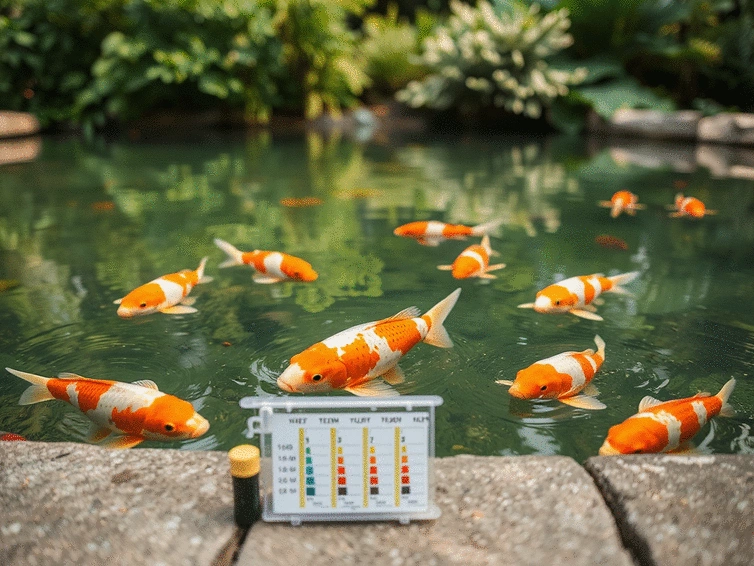
Testing Koi Pond Water Quality
Have you ever considered how the quality of your pond water could make or break your koi's health? Understanding this critical aspect can transform your aquatic habitat into a thriving ecosystem where your beloved fish flourish.
What You Will Learn
- Balanced water quality is essential for optimal koi growth and longevity.
- Recognizing symptoms of poor water quality can save your koi from severe health issues.
- Maintaining proper water temperature is vital for koi metabolism and immune response.
- Dissolved oxygen levels are crucial; ensure adequate aeration to support healthy koi.
- Implementing strategies like limiting nutrients and increasing water movement can combat algae overgrowth.
- Knowing when to seek professional help can protect your koi from serious health problems.
- Proper stocking density is key to preventing stress and promoting a harmonious pond environment.
- Regular water testing and maintenance are essential practices for a thriving koi pond.
Key Factors for Healthy Koi Ponds & Troubleshooting Strategies
Maintaining optimal water quality is crucial for koi health. This visual highlights critical parameters, common issues, and effective solutions for a thriving koi pond ecosystem.
Optimal Water Parameters for Koi Health
Ammonia: 0 ppm (Toxic above 0)
Nitrite: 0 ppm (Toxic above 0)
Nitrate: < 20 ppm (High levels indicate poor water changes)
Dissolved Oxygen: > 6 mg/L (Crucial for respiration)
Temperature: 65-75°F (18-24°C) (Optimal for metabolism)
Troubleshooting Common Koi Pond Issues
Algae Overgrowth
Limit nutrients (control feeding, remove debris), increase water movement (fountains), introduce aquatic plants, regular cleaning.
Fish Stress Symptoms
Unusual swimming, faded colors, surface gulping, lethargy. Mitigate: check water quality, avoid overcrowding, protect from predators, ensure stable environment.
Low Dissolved Oxygen
Often due to warm water. Solution: increase aeration (waterfalls, air pumps), manage plant life (they consume O2 at night).
Poor Stocking Density
Aim for 1 koi per 100 gallons. Overcrowding leads to stress, poor water quality, and aggression. Adjust as fish grow.
Proactive Care & Prevention
- ✓
Regular Water Testing: Essential for early detection of issues.
- ✓
Efficient Filtration: Invest in high-quality systems for clean water.
- ✓
Beneficial Bacteria: Introduce to break down waste.
- ✓
Seasonal Adjustments: Tailor care to changing weather.
- ✓
Water Test Kit Selection: Liquid kits are generally more accurate than strips.
When to Seek Professional Intervention
- ✗
Unexplained Fish Deaths: Multiple fish dying without clear cause.
- ✗
Severe Water Fluctuations: Persistent imbalance despite interventions.
- ✗
Resistant Algae Blooms: Algae that won't respond to standard methods.
- ✗
Undiagnosed Fish Illness: Visible signs of disease you can't identify.
Understanding the Importance of Koi Pond Water Quality for Healthy Fish
As a koi pond enthusiast, I've learned that maintaining high water quality is essential for the health and vitality of your fish. Just like us, koi thrive in clean, well-balanced water, and understanding the factors that contribute to water quality can make a significant difference in their overall well-being. Let's dive into why water quality matters so much for our finned friends!
Healthy koi require a carefully monitored environment, where parameters such as pH, ammonia, and dissolved oxygen are kept within optimal ranges. Neglecting these factors can lead to stress, disease, and even death in our beloved fish. Remember, your koi pond is a living ecosystem, and every element plays a vital role in keeping it thriving! For more detailed information on interpreting water test results, you can refer to resources like Penn State Extension's guide on interpreting water tests for ponds and lakes.

Why Water Quality Matters for Koi Health
Good water quality is the foundation of a successful koi pond. It impacts everything from fish growth to reproduction and even longevity. Here are some key reasons why water quality should be at the forefront of your pond maintenance:
- Healthy fish require a balanced environment for optimal growth.
- Clean water reduces the risk of disease and infections.
- Proper water parameters enhance colors and patterns in koi.
- A healthy pond contributes to a vibrant ecosystem, benefiting all aquatic life.
By prioritizing water quality, you're setting the stage for a thriving aquatic environment that enhances the beauty of your outdoor space. It’s truly rewarding to see your koi flourish in an ecosystem you’ve cultivated with care. You can find additional insights into common water quality concerns and their impact on pond health through Penn State Extension's article on water quality concerns for ponds.
Common Symptoms of Poor Water Quality in Koi
As koi keepers, we must be vigilant about the signs of poor water quality. Recognizing these symptoms early can help prevent severe health issues. Here are some common indicators that your pond may need immediate attention:
- Unusual swimming patterns or lethargy in koi.
- Faded colors or frayed fins.
- Increased surface gulping or abnormal breathing.
- Visible algae growth or murky water.
If you notice any of these signs, it’s essential to take action quickly! Regular testing and monitoring can help you spot issues before they escalate, ensuring a safe and healthy environment for your koi.
Impact of Water Temperature on Koi Fish Health
The temperature of your pond water is another critical factor in maintaining koi health. Koi are ectothermic, meaning their body temperature is regulated by their environment. Extreme temperatures can cause stress and even inhibit growth. The ideal temperature range for koi typically falls between 65°F to 75°F (18°C to 24°C).
- Warm water promotes faster metabolism and growth.
- Cold water can slow down their immune response.
- Rapid temperature fluctuations can be harmful and cause stress.
Monitoring water temperature, especially during seasonal changes, is vital. Consider investing in a reliable thermometer to keep tabs on this important aspect of your koi's habitat!
The Role of Dissolved Oxygen in Koi Pond Ecosystems
Dissolved oxygen is crucial for the health of koi and the overall pond ecosystem. Fish need oxygen to breathe, and low levels can lead to serious health problems. Maintaining proper oxygen levels is essential for a thriving pond. Here are some factors that influence dissolved oxygen:
- Water temperature: Warmer water holds less oxygen.
- Plant life: Aquatic plants can help increase oxygen levels during the day.
- Water movement: Aeration techniques, like fountains and waterfalls, can enhance oxygenation.
By ensuring adequate dissolved oxygen levels, you’ll create a healthier environment for your koi to thrive and enjoy life in your beautiful pond!
Pro Tip
Did you know? Regularly changing about 10-15% of your pond water every couple of weeks can significantly improve water quality and fish health. This simple action helps dilute harmful substances and replenish essential minerals, creating a more stable environment for your koi.
Strategies for Troubleshooting Persistent Water Quality Issues
Maintaining a koi pond can sometimes feel like a balancing act, especially when water quality issues arise. As a koi pond enthusiast, I’ve faced my share of challenges, including algae overgrowth and unexpected water changes. Let's explore effective strategies to troubleshoot these persistent problems and keep our aquatic friends thriving!
Identifying Tricky Problems Like Algae Overgrowth
Algae overgrowth can quickly turn your serene pond into a green soup, affecting both water quality and fish health. To tackle this issue, I recommend implementing the following approaches:
- Limit Nutrients: Reduce excess nutrients in the water by controlling feeding habits and regularly removing debris.
- Increase Water Movement: Installing a fountain or waterfall can enhance oxygen levels and disrupt algae growth.
- Introduce Competition: Adding aquatic plants can help absorb nutrients, limiting what algae can use to thrive.
- Regular Cleaning: Routinely clean the pond and its filters to prevent algae spores from taking hold.
As you work through these strategies, remember that patience is key! It may take time to see improvements, but your efforts will contribute to a healthier pond ecosystem.
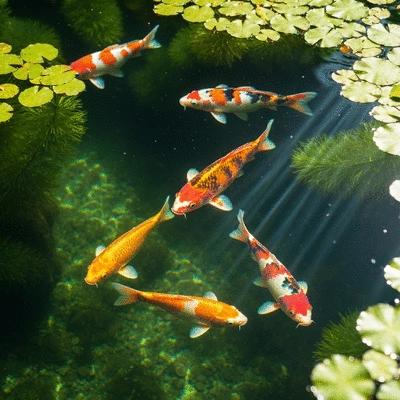
When to Seek Professional Help for Koi Pond Issues
Sometimes, despite our best efforts, we encounter issues that require professional intervention. Here are some signs that it might be time to call for help:
- Unexplained fish deaths or illness.
- Severe water quality fluctuations that you can't manage alone.
- Persistent algae blooms that resist your control measures.
- Clear signs of disease in your koi that you can't diagnose.
Seeking professional assistance can save you time and help protect your koi from further stress. Remember, they depend on us for their wellbeing!
Common Causes of Stress in Fish and How to Mitigate Them
Koi fish can experience stress due to various factors, impacting their health and overall happiness. Some common stressors include:
- Water Quality Issues: Poor water conditions lead to stress and disease.
- Overcrowding: Ensure that your pond isn’t overstocked, as this can lead to aggression and stress.
- Predator Presence: Protect your pond from potential predators that can frighten your fish.
- Environmental Changes: Sudden changes in temperature or water chemistry can cause panic.
By regularly testing water quality and keeping an eye on your koi’s behavior, you can identify stressors early and take action. Remember, happy koi make for a beautiful pond experience!
Engaging FAQs About Koi Pond Water Quality
As koi enthusiasts, we often have questions about the best practices for water testing. Let’s address some common FAQs that can enhance our understanding of water quality management.
Frequently Asked Questions
What are the optimal water parameters for koi health?
The optimal water parameters for koi health are: pH between 7.0-8.0, 0 ppm ammonia, 0 ppm nitrite, less than 20 ppm nitrate, dissolved oxygen greater than 6 mg/L, and a temperature between 65-75°F (18-24°C).
How can I tell if my koi are stressed due to poor water quality?
Signs of stressed koi include unusual swimming patterns, faded colors, surface gulping, lethargy, and abnormal breathing. If you observe these symptoms, it's crucial to check your water quality immediately.
What is the impact of water temperature on koi?
Water temperature significantly affects koi metabolism and immune response. While warm water (65-75°F) promotes growth, rapid fluctuations or extreme temperatures can cause stress and inhibit their immune system.
Why is dissolved oxygen important for koi ponds, and how can I maintain it?
Dissolved oxygen is vital for koi respiration. Low levels can lead to serious health issues. You can maintain proper oxygen levels by increasing aeration with waterfalls or air pumps and managing plant life, as plants consume oxygen at night.
What should I do if my pond has an algae overgrowth?
To combat algae overgrowth, limit nutrients by controlling feeding and removing debris, increase water movement with fountains, introduce aquatic plants to absorb nutrients, and perform regular cleaning of the pond and filters.
When should I seek professional help for my koi pond?
You should seek professional help if you experience unexplained fish deaths, severe and persistent water quality fluctuations, algae blooms that resist standard control methods, or undiagnosed fish illnesses.
What is appropriate stocking density for a koi pond?
A good rule of thumb is to aim for one koi per 100 gallons of water. Overcrowding can lead to stress, poor water quality, and aggression among fish. Adjust as your koi grow.
Are liquid test kits better than test strips for koi pond water?
Yes, liquid test kits are generally more accurate and reliable than test strips for measuring water parameters in a koi pond. While strips offer convenience, liquid kits provide more precise readings, which are crucial for maintaining optimal water quality.
Encouraging Healthy Koi Fish Through Proactive Care
Taking a proactive approach to koi care is essential for the longevity and health of your fish. By implementing advanced pond maintenance techniques, you’ll create a thriving environment for your koi to flourish!
Integrating Advanced Pond Maintenance Techniques
One way to boost your pond's health is by integrating advanced maintenance techniques. Here are a few methods I've found effective:
- Regular Water Testing: Make it a habit to test water parameters regularly to catch any issues early.
- Efficient Filtration Systems: Invest in high-quality filters to ensure clean water at all times.
- Beneficial Bacteria: Introduce beneficial bacteria to help break down waste and improve water quality.
- Seasonal Adjustments: Tailor your maintenance routine based on the season to address specific challenges.
By being proactive, you’re not only enhancing the aesthetics of your pond but also investing in your koi’s health!
Case Studies: Successful Water Quality Management Examples
Real-life examples can provide invaluable insights. For instance, I once helped a fellow koi enthusiast who struggled with persistent algae blooms. After implementing a combination of improved filtration and aquatic plants, the water clarity improved significantly, and the koi thrived!
These success stories remind us that with the right strategies, we can create a thriving aquatic environment. Have you experienced a similar transformation in your pond?
Understanding Fish Stocking Density and Its Impact on Health
One critical aspect of maintaining healthy koi is understanding the importance of stocking density. Here’s what I recommend keeping in mind:
- For every 100 gallons of water, aim for one koi fish to ensure adequate space and resources.
- Monitor fish growth; as koi grow, you may need to adjust their environment accordingly.
- Avoid overcrowding to reduce stress and promote optimal health.
- Regularly observe fish behavior to spot signs of stress or aggression.
By managing stocking density thoughtfully, you're setting the foundation for a healthy and harmonious pond ecosystem. For further guidelines on managing your pond's ecosystem, including stocking rates and water quality, you can consult New Mexico State University's publication on pond management.
Engaging FAQs About Koi Pond Water Testing
As koi enthusiasts, we often have questions about the best practices for water testing. Let’s address some common FAQs that can enhance our understanding of water quality management.
Common Misconceptions About Koi Pond Care
Many misconceptions can lead to poor pond maintenance practices. For example, some believe that a little algae is harmless. In reality, excessive algae can lead to oxygen depletion, harming your fish! Understanding the facts helps us take better care of our koi.
Expert Answers to Reader Questions on Water Quality
I've gathered some top questions from our community regarding water quality:
- What should I test for besides pH?
- How often should I replace the water in my pond?
- Are there natural ways to improve water quality?
These FAQs guide us in fostering a greater understanding of koi pond care. Don't hesitate to ask more questions—it's how we all learn!
How to Select the Right Water Test Kits for Your Needs
Choosing the right testing kit can make a huge difference. Here’s what to consider:
- Choose kits that test for key parameters like ammonia, nitrites, nitrates, and pH.
- Liquid test kits often provide more accurate readings compared to strips.
- Digital testers can offer convenience but may come at a higher cost.
By selecting the right tools, you'll equip yourself for effective water quality management!
Conclusion: Committing to Regular Testing for Thriving Koi
As we wrap up this deep dive into water quality and its impact on koi health, let’s recap the key steps to maintain a thriving pond:
- Establish a regular testing schedule.
- Take immediate action if levels go out of range.
- Keep your pond clean and well-maintained.
Remember, prioritizing water quality and actively monitoring your pond will lead to healthier koi and a more beautiful aquatic environment. Let's keep our ponds vibrant and our koi happy!
Recap of Key Points
Here is a quick recap of the important points discussed in the article:
- Maintaining high water quality is essential for the health and vitality of koi fish.
- Key water parameters include pH, ammonia, and dissolved oxygen, which must be monitored regularly.
- Signs of poor water quality include unusual swimming patterns, faded colors, and murky water.
- Temperature control is crucial, as ideal conditions range between 65°F to 75°F (18°C to 24°C).
- Dissolved oxygen levels must be maintained, as low levels can lead to serious health problems for koi.
- Implementing advanced maintenance techniques, such as regular testing and efficient filtration, enhances pond health.
- Understanding stocking density is vital to ensure adequate space and resources for koi.

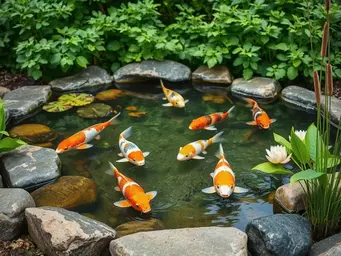
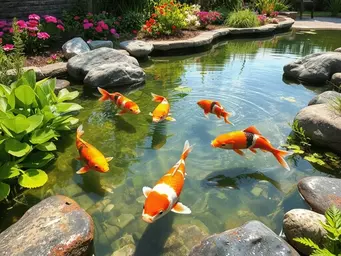
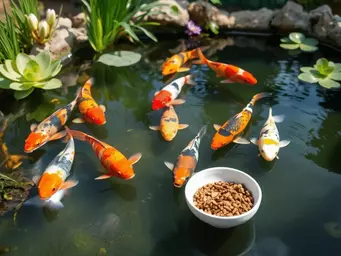
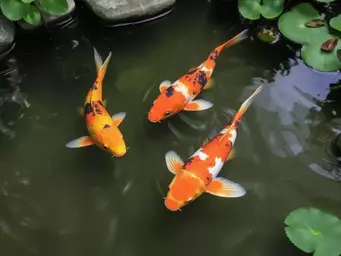
Koi Pond Budgeting Made Simple
Building a Self-Sustaining Koi Pond
Koi Care Tips for Every Season
Managing Koi Pond Chemical Levels
Koi Pond Building Mistakes to Avoid